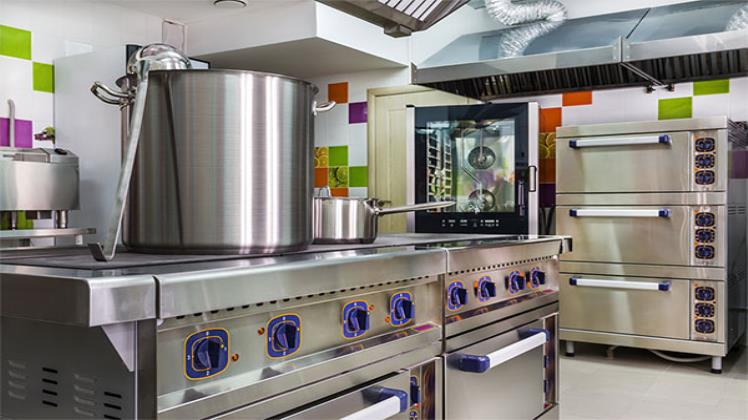A restaurant’s operational efficiency hinges on the reliability and durability of its kitchen appliances. In Singapore’s competitive F&B environment, where precision and speed are paramount, investing in high-quality, commercial-grade equipment is essential. This article delves into the indispensable commercial kitchen appliances, highlights the advantages they offer over consumer variants, and outlines key considerations for restaurateurs when procuring restaurant equipment.
Common Commercial Kitchen Appliances
Cooking Equipment: Commercial-grade ranges, broilers, griddles, and ovens are designed for prolonged and intense use. They offer stronger heat output, responsive controls, and versatile heating options such as forced air or infrared heat.
Refrigeration Units: From blast chillers to cold rooms, commercial fridges are built to store large volumes of ingredients reliably. The use of stainless steel ensures resistance to stains and dents, while precise cooling mechanisms preserve freshness.
Exhaust Systems: Heavy-duty centrally ducted extraction systems are crucial for removing cooking fumes, smoke, grease, and lingering odors. These systems, equipped with high-powered motors, not only maintain a comfortable kitchen environment but also meet fire safety codes.
Food Preparation Machines: Commercial blenders, meat slicers, juicers, and processors are engineered to withstand hours of continuous operation when preparing large food batches.
Warewashing Equipment: Industrial-grade dishwashers equipped with chemical or temperature sensors sanitize high volumes of dishes quickly, ensuring uninterrupted service.
Reasons to Invest on Reliable Restaurant Kitchen Appliance for Your Business
Consumer appliances fall short in commercial settings due to various reasons:
Frequent Use: Components wear out quicker with the intense and constant usage in commercial kitchens.
Limited Capacity: Smaller chamber sizes are inadequate for handling the large volumes typically encountered in restaurants.
Temperature Restrictions: Limited temperature ranges in consumer appliances can hinder the cooking process.
Build Materials: Plastic parts in consumer appliances degrade faster under the stress of commercial use.
Safety Features: Consumer appliances often lack specialist safety features required in commercial kitchens, such as low water cut-offs.
Power Ratings: Insufficient power ratings in consumer appliances can slow down production.
Component Availability: Limited or no local inventory for replacement components of consumer appliances.
Commercial Benefits of Restaurant Kitchen Appliances
Commercial appliances offer several key advantages:
Specialized Durability: Built to withstand high usage demands, ensuring a longer lifespan.
Generous Sizing: Designed to handle large volumes of ingredients and food batches.
Power and Heat Output: Equipped to meet the speed demands of commercial kitchens.
All-Metal Construction: Resistance to wear and tear with durable metal construction.
Safety and Efficiency Protections: Built-in safety features and efficiency protections for smooth operations.
Local Warranty Support Services: Access to local support services for timely maintenance and repairs.
Esteemed Reputations: Brands like Vulcan or Manitowoc often enjoy esteemed reputations for their commercial appliances.
Evaluation Considerations When Purchasing Kitchen Appliances for Restaurants
Key aspects to consider when evaluating appliances:
Output Scale: Ensure the appliance’s output scale aligns with projected orders.
Build Quality: Assess the build quality to ensure it can sustain the rapid pace of a commercial kitchen.
Footprint Dimensions: Check if the restaurant kitchen appliance‘s dimensions are compatible with the kitchen layout.
Maintenance Availability: Ensure that commissioned maintenance is readily available.
Responsive Controls: Responsive controls are crucial for real-time adjustments during cooking.
Intuitive Interfaces: Appliances should have intuitive interfaces for easy staff transition after training.
Energy Efficiency: Opt for energy-efficient models to optimize running costs.
Regulatory Compliance: Verify compliance with safety and emissions regulations.
Conclusion
In Singapore’s competitive F&B landscape, the success of a restaurant is intricately tied to the efficiency of its kitchen. Investing in heavy-duty, commercial-grade kitchen equipment ensures not only productivity and excellence in output but also a positive working experience for chefs. Careful evaluation based on durability, sizing suitability, and after-sales support guarantees reliable performance. While the upfront capital investment may be higher, the long-term benefits of robust commercial appliances include faster production, consistent execution, and extended usage lifespans, securing returns on investment for restaurant owners.

